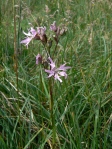Alex Cripps – Conservation Graduate Trainee
I recently carried out the Levisham Botanical Survey for this year with the help of Dawn Rothwell, our current Volunteer Service Assistant and a keen Volunteer herself, and Sam Lightfoot, LEADER Volunteer.
Levisham Estate is one of the very few areas in the North York Moors actually owned by the North York Moors National Park Authority. It’s just north of Pickering and the land holding is made up of c. 1,360 ha of moorland, woodland, and upland farmland..The overall aim of management on the Estate is to maximise the contribution of the Estate to National Park Purposes
 The purpose of the annual Levisham Botanical survey is to ascertain if bracken/scrub encroachment and over grazing are still having a detrimental effect on sites which had been identified as being species rich and of high botanical interest in the past. The Survey has been carried out most years since 2006 and the results help inform us on further management, or suggest changes to the current management, in order to improve the botanical value of the sites.
The purpose of the annual Levisham Botanical survey is to ascertain if bracken/scrub encroachment and over grazing are still having a detrimental effect on sites which had been identified as being species rich and of high botanical interest in the past. The Survey has been carried out most years since 2006 and the results help inform us on further management, or suggest changes to the current management, in order to improve the botanical value of the sites.
Three specific exclosures (4m x 4m) have been set up in Levisham Bottoms, the Hole of Horcum and on Levisham Moor. The exclosures are monitored each year to compare species diversity within the exclosures where grazing is eliminated compared to the surrounding area where grazing continues.
Over the years since 2006 the areas outside the exclosures have greatly improved due to the change in grazing pressure on Levisham Estate. A balance is needed between over grazing/management and not enough management allowing scrub to build up at the expense of other habitats.


 This year six additional sites were surveyed that hadn’t been monitored since 2007. These sites had previously had an indication of over grazing and bracken encroachment/shading. Some of these additional sites are still species rich but others are suffering from overgrazing, resulting in species being miniature in appearance. Some sites are under severe threat from bracken and gorse encroachment and have reduced in size since they were previously surveyed.
This year six additional sites were surveyed that hadn’t been monitored since 2007. These sites had previously had an indication of over grazing and bracken encroachment/shading. Some of these additional sites are still species rich but others are suffering from overgrazing, resulting in species being miniature in appearance. Some sites are under severe threat from bracken and gorse encroachment and have reduced in size since they were previously surveyed.

 All in all however sites have greatly improved as a result of active management – bracken and scrub clearance – that has been carried out in the last few years. These sites, such as a species rich flush in the Hole of Horcum and a roadside flush near Levisham Station, are really special. A flush is an area of wet ground fed from ground water. Plant species such as Black bog-rush, Round-leaved sundew, Common butterwort, Bog pimpernel and Ragged robin have been found in good numbers. These areas are also attracting other species such as the Small pearl-bordered fritillary butterfly, Golden-ringed dragonfly and the Common lizard.
All in all however sites have greatly improved as a result of active management – bracken and scrub clearance – that has been carried out in the last few years. These sites, such as a species rich flush in the Hole of Horcum and a roadside flush near Levisham Station, are really special. A flush is an area of wet ground fed from ground water. Plant species such as Black bog-rush, Round-leaved sundew, Common butterwort, Bog pimpernel and Ragged robin have been found in good numbers. These areas are also attracting other species such as the Small pearl-bordered fritillary butterfly, Golden-ringed dragonfly and the Common lizard.











Pingback: Volunteering in and out of the Office | The official blog for the North York Moors National Park
Pingback: Woodland with added purpose | The official blog for the North York Moors National Park
Pingback: Slowing down | The official blog for the North York Moors National Park